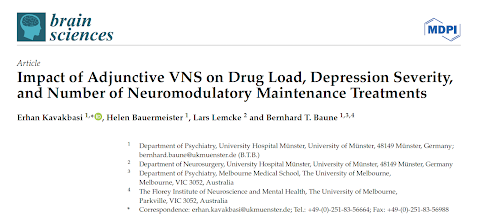Dexmedetomidine For BP Control in ECT: Study From Thailand
Out on PubMed, from investigators in Thailand, is this study:
Premedication with dexmedetomidine for prevention of hyperdynamic response after electroconvulsive therapy: a cross-over, randomized controlled trial.
BMC Psychiatry. 2021 Aug 17;21(1):408. doi: 10.1186/s12888-021-03406-9.PMID: 34404384
Background: Electroconvulsive therapy (ECT) is an effective therapy for psychiatric disorders, but is associated with acute hyperdynamic responses including transient hypertension and tachycardia. This study aimed to assess the effectiveness of premedication with dexmedetomidine for hemodynamic attenuation after ECT and to evaluate its effects on seizure duration, postictal asystole duration, post ECT agitation and recovery time.
Methods: Twenty-four psychiatric patients who underwent a total of 72 ECT sessions (three sessions per patient) were randomly allocated to receive either dexmedetomidine 0.5 mcg/kg intravenous, dexmedetomidine 1 mcg/kg intravenous, or saline (control group) 15 min before the first ECT session. The patients subsequently received the other two premedication options for their next two ECT sessions. Blood pressure and heart rate were recorded at 5, 10, and 15 min after drug infusion and at 2.5, 5, 7.5, 10, 15, 20, 25, and 30 min after ECT. Asystole duration, seizure duration, post ECT agitation and recovery times were also recorded.
Results: The baseline characteristics were similar between the groups. Systolic blood pressure in both dexmedetomidine groups was significantly lower than that in the control group after ECT (p = 0.002). Diastolic blood pressure and heart rate were significantly lower in the dexmedetomidine 1 mcg/kg group (p = 0.002 and p = 0.013, respectively) compared with the control group. Asystole duration, seizure durations, post ECT agitation and recovery times were similar between the groups.
Conclusions: Dexmedetomidine 1 mcg/kg administered 15 min before ECT attenuated the hemodynamic response, including suppressing the systolic, diastolic and heart rate increases, during ECT without affecting recovery time. It also did not prolong the post-stimulus asystole duration.
Trial registration: TCTR20170715003 , registered at Thai Clinical Trials Registry (TCTR), principal investigator: Pattika Subsoontorn, date of registration: 15/07/2017.
Keywords: Acute hyperdynamic response; Dexmedetomidine; Electroconvulsive therapy.
The pdf is here.
And from the text:
Conclusion
Dexmedetomidine 1 mcg/kg administered 15 min before
ECT attenuated the hemodynamic response, including
suppressing the systolic, diastolic and HR increases, during ECT without affecting recovery time. It also did not
prolong the post-stimulus asystole duration. However,
motor seizure duration was slightly shorter with this
dexmedetomidine dose than with the 0.5 mcg/kg dose
or saline, which may affect the quality of ECT. Decreasing the dexmedetomidine dose to 0.5 mcg/kg improved
motor seizure duration compared with dexmedetomidine 1 mcg/kg, but also decreased the degree of
hemodynamic attenuation.
Students of ECT anesthesia will want to read this paper in full, (~15 minutes). Kudos to our colleagues in Thailand for putting these useful data in the ECT literature.







Comments
Post a Comment